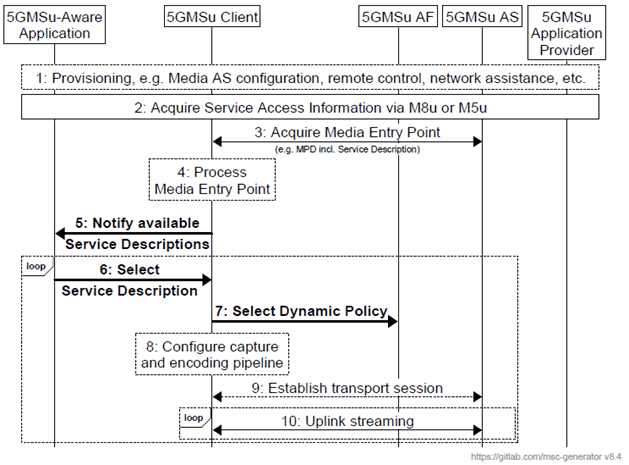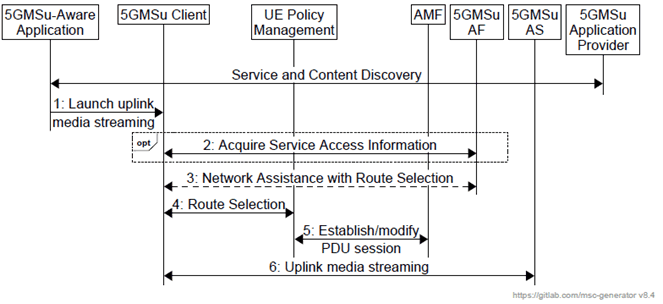Content for TS 26.501 Word version: 18.6.0
1…
4…
4.0.6…
4.1…
4.2…
4.2.2…
4.3…
4.4
4.5…
4.6…
4.7…
4.7.4…
4.8
4.9…
4.10…
5…
5.2…
5.2.4
5.2.5…
5.3…
5.3.2…
5.4…
5.5…
5.6…
5.7…
5.7.4…
5.7.8
5.8…
5.10…
5.10.5…
5.10.6…
5.11…
5.12…
5.12.4…
5.12.5…
6…
6.2…
6.2.2.2…
6.2.3…
6.3…
6.4…
6.8…
6.9…
6.9.5…
6.9.7
7…
8…
9…
A…
A.4…
A.8
A.9
A.10
A.11
A.12
A.13
A.14
A.15…
A.15.3…
B…
B.3
C…
C.3
C.4
C.5
D…
E…
6.9.5 Dynamic Policy selection for uplink media streaming based on Service Operation Point signalling
6.9.6 Dynamic Policy based on Network Slicing for uplink media streaming
...
...
6.9.5 Dynamic Policy selection for uplink media streaming based on Service Operation Point signalling p. 178
This clause provides an extension to the general call flow in clause 6.2.3 in order to address the usage of Service Descriptions to select a Dynamic Policy in uplink 5G Media Streaming services that supports the requirements of an abstract Service Operation Point. Details are shown in Figure 6.9.5-1.

Figure 6.9.5-1: High-level procedure for uplink media streaming with Service Operation Point handling
(⇒ copy of original 3GPP image)
(⇒ copy of original 3GPP image)
Steps:
Step 1.
Policy Templates are provisioned in the 5GMSd AF and various configurations are performed.
Step 2.
Either the 5GMSu-Aware Application acquires Service Access Information from the 5GMSu Application Provider via reference point M8u, or else Service Access Information is acquired by the 5GMSu Client from the 5GMSu AF via reference point M5u (as defined in steps 7-11 of Figure 6.2.2.2-1).
Step 3.
The 5GMSu Client acquires the Media Entry Point from the 5GMSu AS.
Step 4.
The 5GMSu Client processes the Media Entry Point to discover the set of available Service Descriptions, each one identified by a different External reference.
Step 5.
The 5GMSu Client notifies the 5GMSu Application about the available Service Descriptions.
Step 6.
The 5GMSu Application selects a Service Description and notifies the 5GMSu Client by supplying its External reference.
Step 7.
The 5GMSu Client selects a Dynamic Policy with a matching External reference.
Step 8.
The 5GMSu Client configures its capture and encoding according to the selected Service Description.
Step 9.
A transport session is established by the 5GMSu Client for uplink media streaming.
Step 10.
Media is streamed to the 5GMSu AS via the uplink.
6.9.6 Dynamic Policy based on Network Slicing for uplink media streaming p. 179
The 5GMSu Application Provider requests the assignment of more than one network slice for the uplink media streaming service. The 5GMSu Application Provider indicates the desired network slice features that correspond to the Service Access Information. Upon successful assignment of the network slices for the service, the 5GMSu AF shall respond with the list of allowed S-NSSAIs to the 5GMSu Application Provider.
Figure 6.9.6-1 is the sequence diagram for this procedure.

Figure 6.9.6-1: Dynamic Policy based on Network Slicing for uplink streaming
(⇒ copy of original 3GPP image)
(⇒ copy of original 3GPP image)
Pre-requisites:
- The UE knows how to access the network slice(s) associated with a particular Provisioning Session.
- The 5GMSu AS instance(s) serving the content for the particular Provisioning Session are accessible through the DNN(s) associated with the network slice(s) provisioned for the contribution of that content.
Step 1.
The 5GMSu-Aware Application triggers the 5GMSu Client for uplink media streaming of content.
Step 2.
If it has not already been provided with the necessary Service Announcement parameters by the 5GMSu-Aware Application in the previous step, the Media Session Handler in the 5GMSu Client retrieves Service Access Information from the 5GMSu AF for the Provisioning Session of interest.
Step 3.
The Media Session Handler in the 5GMSu Client invokes Network Assistance on the 5GMSu AF and receives information in response to assist it with the route selection for the uplink media streaming session. This may include information about the network slices, the DNNs and any pre-authorized QoS guarantees for that Provisioning Session.
Step 4.
The 5GMSu Client and the UE Policy Management in the UE perform the route selection procedure using information such as the uplink streaming Service Operation Point and the traffic descriptors. The UE Policy Management uses the matching filter to retrieve the Route Selection descriptor, which provides the DNN and the S-NSSAI(s) identifying the network slice(s) to be used for uplink media streaming sessions associated with this Provisioning Session.
Step 5.
The UE either reuses an existing PDU Session with the selected S-NSSAI and DNN from step 3 or, if one doesn't exist already, it requests the establishment of a new PDU Session with the identified parameters.
Step 6.
The 5GMSu Client contributes media content to the 5GMSu AS at reference point M4u using the PDU Session selected in the previous step and this content is made available to the 5GMSu Application Provider at reference point M2u.